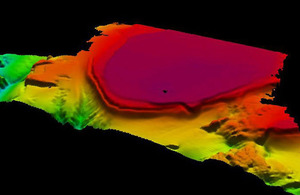HMS Echo charts pirate waters
Royal Navy survey ship HMS Echo is supporting the anti-piracy effort in the Indian Ocean by updating badly-needed charts of the region and eliminating no-go areas for Allied warships.

An example of sea bottom mapping [Picture: Crown Copyright/MOD 2011]
Not only is the Somali Basin a hotbed of piratical activity, but the charts of the waters here are old and inadequate so Echo was sent in to provide much-needed data including reams of bathymetric data - which record the depth of the oceans.
The data will be fed back to the UK Hydrographic Office in Taunton to allow its cartographers to produce up-to-date charts for lawful seafarers.
Among the features Echo’s state-of-the-art sensors has recorded is a guyot (pronounced ge-oh) - a flat-topped sea mountain rising hundreds of metres from the seabed in the Somali Basin.
The ship’s Commanding Officer Commander Michael O’Sullivan said:
This region is at the centre of current piracy activity and it is also a region of sparse environmental data, so HMS Echo’s work is important in providing coalition warships with the environmental edge in deterring this nefarious activity.
As well as gathering vital hydrographic info in the Indian Ocean, Echo has also conducted three rendezvous recently from her sister Enterprise (just back in the UK on 10 June 2011) to the Black Duke HMS Monmouth to the giant helicopter training/medical ship RFA Argus.

HM Ships Echo and Enterprise operating together [Picture: Crown Copyright/MOD 2011]
Echo met Argus and Enterprise at sea, while she encountered Monmouth in Muscat as the latter took a break from anti-piracy operations in the region.
The relatively short visit to the Omani capital allowed the latest rotation of crew - Echo is sustained in theatre in the long run by changing one third of her ship’s company regularly - lots of mail and spare parts and stores delivered, courtesy of the RAF.
The Omani Navy was keen to see the work that Echo’s been doing so its senior officers, led by the senior hydrographer, filed aboard - as did his RN counterpart.
Captain Vaughan Nail (a former CO of HMS Enterprise) was in the region for some first-hand experience of the work ‘the two Es’ have been carrying out.
Although both ships were in the same area of operations, they’d not met up for more than a year. So there was a series of officer of the watch manoeuvres and transfers of stores by line and personnel (one Capt Nail) by boat, among other exercises.
Aboard Echo, the Hydrographer of the Navy witnessed the ship practising her Chemical-Biological-Radiological-Nuclear Defence.
The ship tested her ‘sanctuary’ or ‘citadel’ - making the core of the ship airtight and impenetrable to toxic gases and substances - and her ability to wash those nasties away, courtesy of her pre-wetting sprinkler system.
Before heading back to the UK Capt Nail stressed the importance of the work the two survey ships had been doing in the region and praised Echo:
HMS Echo’s made an excellent start to this challenging deployment with several notable accomplishments already under her belt.
There is a sharp operational edge to the Echo which is clearly the result of careful planning and training, underpinned by a strong spirit and sense of mission.
The third ship to link up with Echo recently, RFA Argus, is also supporting the concerted counter-piracy effort off the Horn of Africa, serving as a base for Royal Marines and Merlin helicopters from 820 Naval Air Squadron.
As with the rendezvous with Enterprise, meeting Argus allowed some good officer of the watch practice, not least for the young officers undergoing training on Echo.